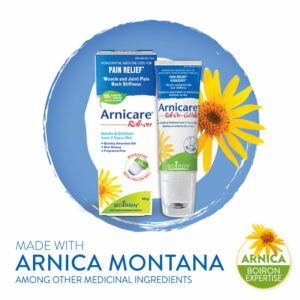5 natural tips against fall weather Aches & Pain
Fall Weather Aches & Pain: Top 5 Tips for Natural Support
By Kyle Buchanan
And just like that, we’re halfway through fall, with winter right around the corner. Now as Canadians, we know this dance very well. The wind gets stronger, the nights get darker, and the cold gets mightier.
Now I might be alone in this (and I welcome any angry emails!) but I’m a fan of the colder weather. It’s cozier, the air feels cleaner and most importantly, it’s sweater weather and for some weird reason, the sheer act of putting on a big knit sweater puts me in a good mood. Anyone else?
The one thing that I’m not as big a fan of this time of year is the increased likelihood for aches and pains to start popping up.
You might be wondering, what the heck does the colder weather have to do with an increase in the “ouchies?” But hear me out! Whether spending time outside, or stuck forcibly inside, the cold weather can present a challenge for a couple of reasons:
When we’re actually out and about outside in the colder weather, our muscles tend to stiffen up. Think of that feeling when you’re walking against the blustery cold wind, hunching your shoulders as your eyes tear up, trying to walk as fast as you can to get to where you need to be. When we’re more stiff and tense like this in the cold weather, our flexibility is reduced and we can become more susceptible to strains. This is especially true if you are doing outdoor exercise (i.e. hockey, skiing) without properly warming up.
And that’s when we’re outdoors! If it is colder out, chances are we’re spending more time indoors than we might be used to – sitting on the couch, the desk or at the kitchen table – which can bring with it its own aches and pains, whether it’s a sore lower back or neck as a result of sitting starting at the computer, or even our poor little wrists typing away all day (they really deserve more love than they get!).
So with that, I wanted to suggest 5 natural ways to support your body, both preventatively, so you’re less likely to get injured, and also reactively, so you have tools and tips to support your system should you happen to get injured.
If you know of anyone who tends to deal with injuries, be sure to forward them this article!
Keep on top of your Protein Intake
If there is one thing that I consistently see in practice, it’s that most of us are under-consuming protein. Protein is one of three key macronutrients we need to survive and thrive (the other two being fat, and carbs). In terms of aches and pains, protein is needed for structural support for our cells and tissues – we’re literally made of it! Consequently, under-consuming protein can both increase susceptibility to injury 1 and compromise your body’s ability to repair tissue damage if injuries happen.2
Because of that, you do want to ensure you’re getting enough protein!!
While the RDA (recommended daily allowance) for protein is around 0.8g of protein per kilogram of bodyweight, it’s my professional opinion that that number is typically too low for most of us. Because of that, my recommendation (which is similar to many of my colleagues) is to aim for 0.7g – 1g of protein per pound of body weight per day. Some of my favourite sources include grass-fed meats, eggs, organic poultry, seafood, tempeh (a product made from whole, fermented soybeans),
and soaked legumes. And while I do support getting our nutrients through whole-food sources, when it comes to protein – a protein powder supplement can be an easy way to effortlessly meet your protein goals (I especially find this useful for seniors). If you tolerate dairy – whey protein is incredible and very bioavailable; beyond that – pea protein and fermented vegan protein powders are a great option as well.
Keep on top of your Omega 3s
Just like protein, omega 3 is a major player when it comes to both injury prevention and healing. Two very important Omega 3’s, called EPA and DHA for short, play a multifaceted role in the body’s inflammatory response. In terms of prevention, they help to reduce chronic inflammation3, which can over time, weaken tissues and increase the risk of conditions like arthritis.4
Beyond that, if and when injured, they help the body’s healing process by promoting tissue repair5 as well as playing a role in pain management.6 Food sources like sardines, salmon, walnuts, flax and chia seeds all include different forms of omega 3. Nevertheless I normally recommend supplementation as well, either as a fish-based supplement or algae-based oil if vegan. Omega 3’s are that important!
If hurting – Consider the New Arnicare® Roll-On *

The new Arnicare® Roll-on is a convenient way to apply Arnica montana mother tincture, which is one of its main ingredients, and keep your hands clean at the same time. Using a massaging roller-ball for application, this residue-free, non-sticky, non-greasy, water-based gel formula is quickly absorbed by the skin. And for those sensitive to smells (me!), there is NO strong medicine smell, as the product is free of fragrances, in addition to being dye and paraben free. In addition to relieving joint and muscle pain, the Arnicare® Roll-On offers relief to painful back stiffness. Needless to say, it has quickly become one of my favourites because, as silly as it sounds, to apply something without needing to immediately wash your hands afterwards is that small time saver that really does make a difference.
How to: keep it handy (desk drawer, backpack, purse etc), and when needed, grab and apply a thin layer to the affected area using the roll on and massage gently. Use up to three times daily, or as needed!
Keep on top of your Vitamin D (and Calcium!)
This is my friendly-fall-reminder to take your Vitamin D supplement every day. Vitamin D is crucial for so many reasons, but with regards to this article – your bones need Vitamin D to help you absorb the calcium from your diet. Like not getting enough protein, not getting enough Vitamin D (or calcium) can increase the risk of injuries, as well as things like hip fractures.7 So to both help prevent injuries, and help support your body’s natural healing process should you get injured, remember to take Vitamin D every day (and consider getting your levels tested), as well as increasing Calcium rich foods like collard greens, tempeh, sesame seeds, yogurt and sardines!
Move, move, move!
I consider movement to be preventative medicine, and a daily dose goes a long way to preventing the risk of injuries. So whether it’s going for a walk, adding in some resistance training (which is so incredibly important for bone density and bone health), or adding in something new like hula hooping (a REALLY underestimated exercise) – movement helps improve flexibility, balance and coordination, all of which can help reduce the likelihood of accidents and injuries. 8 Just be sure to warm up before you move, especially if you are going out in the cold!
Closing Thoughts
Whether you’re a fan of the colder weather or not, whether you want to embrace the knit sweater or just turn up the heat and put on a tank top to reminisce about warmer days . . . the fact remains: winter is coming. And with that, to make the most out of winter as pain and ache free as we can, it’s important to take the steps to nourish your system so you’re as strong as you can be. And should you happen to get that ache or pain, having a natural go-to relief on hand will be something your tomorrow-you will thank you for!
To a comfortable, and strong, fall and winter ahead!
* This homeopathic medicine may not be right for everyone. Always read and follow the label.
About the author:

You can find out more about Kyle’s advice by watching this video, from his appearance on The Morning Show on October 12.
References:
1 https://pubmed.ncbi.nlm.nih.gov/8777079/
2 https://pubmed.ncbi.nlm.nih.gov/12070399/
3 https://pubmed.ncbi.nlm.nih.gov/35914448/
4 https://www.ncbi.nlm.nih.gov/pmc/articles/PMC3638313/
5 https://www.researchgate.net/publication/5380872_Omega-3_fatty_acids_effect_on_wound_healing
6 https://pubmed.ncbi.nlm.nih.gov/17335973/
7 https://pubmed.ncbi.nlm.nih.gov/8777079/
8 https://www.frontiersin.org/articles/10.3389/fpubh.2023.1209319/full

Subscribe and get 15% off
your next purchase of homeopathic medicine at regular price on Boiron shop.
Sign up for our newsletter to receive healthy tips and special offers!

